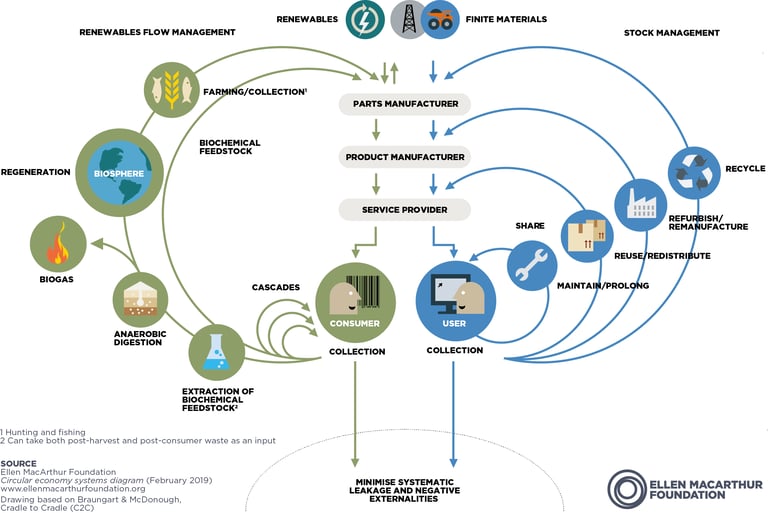From Waste to Wealth: The Global Shift Toward Circular Construction
Across the globe, the construction sector is shifting from a take–make–dispose mentality to circular systems that eliminate waste, maintain the use of materials, and restore value - ranging from Europe’s material passports to urban mining initiatives in Asia. Explore how this is taking shape.
CONSTRUCTION AND ENERGY
Neel Joshi
8/11/20256 min read


The construction industry is among the largest contributors to environmental pollution worldwide. In 2023, the emissions from the industry were at 34 percent, while energy consumption represented approximately 34 percent of global demand. Despite some progress, the construction industry is still not on course to meet net-zero carbon and climate resilience goals by 2050, as advancements are slow and inconsistent. CO₂ emissions from this sector have increased by five percent since 2015, which is far from the 28 percent reduction needed by 2030 to comply with the Paris Agreement.
With urban populations expected to double by 2050, it is crucial to shift from the conventional linear "take–make–dispose" model to a circular economy (CE). In construction, CE emphasizes maximizing resource efficiency, extending the lifespan of materials, and closing material loops, transforming waste into a resource instead of a disposal challenge.
The Concept of Circular Economy in Construction:
In the construction industry, the principles of Circular Economy (CE) encompass:
Creating designs that emphasize durability, adaptability, and disassembly to facilitate material reuse.
Focusing on the use of recycled and renewable materials to reduce the reliance on virgin resources.
Reducing waste through closed-loop systems that allow demolition materials to be directly utilized in new projects.
Utilizing digital tools such as Building Information Modelling (BIM) to monitor material lifecycles and support the creation of 'material passports.'
In contrast to gradual green initiatives, CE represents a systemic shift — it influences the design, procurement, construction, operation, and eventual deconstruction of buildings.


Circular economy framework showing how renewable and finite materials flow through biological and technical cycles. In construction, this means designing buildings for material recovery, reuse, refurbishment, and recycling, while regenerating renewable resources, keeping materials in continuous use, and reducing waste to a minimum.
This diagram from the Ellen MacArthur Foundation depicts the circular economy system as comprising two interlinked loops:
Biological cycle (green loop): Renewable resources are returned to the biosphere via processes such as regeneration, composting, and anaerobic digestion, resulting in the creation of biochemical feedstock and energy.
Technical cycle (blue loop): Finite materials are maintained in circulation through practices such as maintenance, reuse, refurbishment, remanufacturing, and recycling, all of which are supported by sharing models and reverse logistics. The diagram illustrates the collaborative nature of the design, production, use, and recovery phases, highlighting their role in minimizing waste, conserving resources, and mitigating environmental impact.
Key Steps Towards Circular Construction
Policy and Regulation - Numerous nations are incorporating Circular Economy (CE) principles into their laws. The European Union's Circular Economy Action Plan establishes mandatory targets for the recovery of construction waste. In France, it is required that 70% of waste from construction and demolition be either reused or recycled. In Japan, the Construction Material Recycling Law requires contractors to separate waste for recycling.
Material Innovation - The design of low-carbon alternatives, such as geopolymer concrete, reclaimed timber, recycled steel, and bio-based insulation, is underway. Material passports, which originated in the Netherlands, serve to document materials for potential future reuse digitally.
Design Approaches - Modular construction systems facilitate straightforward disassembly. Adaptive reuse strategies prolong the lifespan of current structures.
Waste Management and Reverse Logistics - Urban mining involves extracting valuable resources from existing buildings and infrastructure. Reverse logistics networks are established to gather, process, and redistribute reclaimed materials.
Digitalisation - The integration of Building Information Modelling (BIM) with Circular Economy strategies enables lifecycle modeling and resource optimisation.
Global Instances of Circular Economy in Construction
Netherlands: Leaders in Material Passports
The Netherlands aims to achieve a completely circular economy by 2050. In the construction sector, initiatives like Madaster serve as online databases for the material composition of buildings. This facilitates future reuse, minimizes waste, and transforms buildings into "material banks." Projects such as ABN AMRO’s Circl Pavilion in Amsterdam extensively utilize recycled materials and are designed for easy disassembly.
Finland: Circular Public Procurement
Finland incorporates circular economy principles into its public construction projects. For example, the Helsinki Re-use Centre recovers construction materials from demolition sites and resells them for reuse. The Finnish government also employs procurement criteria that favor designs with high recyclability and minimal lifecycle emissions.
Japan: Resource Efficiency through Regulation
Japan’s Construction Material Recycling Law (2000) requires the sorting of waste from concrete, asphalt, and wood. This regulation has propelled recycling rates for these materials to over 90%. In Tokyo, deconstruction is preferred over demolition, maximizing material recovery.
United Kingdom: Waste Reduction and Modular Housing
The UK has adopted circular economy principles through initiatives such as the WRAP (Waste & Resources Action Programme), which guides minimizing construction waste. Modular housing firms such as Ilke Homes utilize factory-built techniques to reduce waste, facilitate disassembly, and incorporate recycled materials.
United States: Private Sector Innovation
Although federal regulation plays a lesser role in promoting circular economy practices, innovative companies are spearheading the transition. DIRTT Environmental Solutions utilizes prefabricated interior systems that can be reconfigured rather than discarded. In Portland, Oregon, a city ordinance mandates the deconstruction of certain older homes rather than their demolition, allowing for the recovery of up to 80% of materials.
China: Urban Mining and Industrial Symbiosis
China's swift urban redevelopment generates significant material flows. Circular Economy (CE) policies encourage "urban mining" to extract steel, concrete, and various materials from deconstructed buildings. Eco-industrial parks in cities such as Tianjin connect the outputs of construction waste with the inputs of raw materials for manufacturing.
Advantages of Circular Economy in Construction
Environmental: Decreased greenhouse gas emissions, reduced landfill waste, and diminished extraction of virgin materials.
Economic: Lower lifecycle expenses, innovative business models (such as material leasing and resale markets), and enhanced resilience to fluctuations in resource prices.
Social: Generation of green employment opportunities and improved community resilience through adaptive reus
Obstacles and Challenges
Regulatory deficiencies: Numerous regions lack definitive standards for recycled materials.
Cultural resistance: The construction sector often exhibits a conservative approach to embracing new methodologies.
Technological constraints: Recycling methods for intricate materials (like composites) are still in the early stages of development.
Data management: The implementation of material passports necessitates collaboration throughout the supply chain.
Future Perspectives
The momentum for Circular Economy in construction is gaining speed due to:
International agreements such as the UN’s Sustainable Development Goals and the Paris Agreement.
Increasing material scarcity driving the need for more efficient utilization.
Progress in digitization facilitating lifecycle tracking and the establishment of material marketplaces.
Emerging trends encompass:
Blockchain-enabled material registries for clear tracking.
Bio-based materials sourced from agricultural waste or mycelium.
Service-oriented models where materials are leased instead of sold, promoting durability.
Final Thoughts
Circular economy strategies in construction signify a significant transition from linear consumption to regenerative systems. Although advancements differ by nation, successful instances demonstrate that Circular Economy is both practical and advantageous when bolstered by strong policies, innovative business strategies, and technological progress. As urbanization persists, expanding the Circular Economy will be vital to ensuring that the construction sector becomes a proponent — rather than an obstacle — to global sustainability.
References:
Bhavsar, V., Sridharan, S.R. and Sudarsan, J.S. (2023) ‘Barriers to circular economy practices during construction and demolition waste management in an emerging economy’, Resources, Conservation & Recycling Advances, 20, p. 200198. doi:10.1016/j.rcradv.2023.200198.
Ellen MacArthurFoundation 2015. What is a circular economy? [Online]. Available from: https://www.ellenmacarthurfoundation.org/topics/circular-economy-introduction/overview European Commission 2020. Circular Economy Action Plan. [Online]. Available from https://op.europa.eu/en/publication-detail/-/publication/45cc30f6-cd57-11ea-adf7-01aa75ed71a1/language-en
Ellen MacArthur Foundation (2018). THE CIRCULAR ECONOMY OPPORTUNITY FOR URBAN & INDUSTRIAL INNOVATION IN CHINA. [Online]. Available from https://content.ellenmacarthurfoundation.org/m/1ecdad1c9d3313d0/original/The-circular-economy-opportunity-for-urban-and-industrial-innovation-in-China.pdf
European Environment Agency (2024). Circular economy country profile 2024 – Finland. [Online]. Available from https://www.eea.europa.eu/en/topics/in-depth/circular-economy/country-profiles-on-circular-economy/circular-economy-country-profiles-2024/finland_2024-ce-country-profile_final.pdf/
Ghaffar, S.H. and Mullett, P. Completing the Circle – How Digitalization will Unlock Circular Construction, BSI Group. Available at: https://www.bsigroup.com/en-GB/industries-and-sectors/construction-and-the-built-environment/bsi-identify/bsi-identify-whitepaper-completing-the-circle/ (Accessed: 10 August 2025).
Swarnakar, V. and Khalfan, M. (2024) ‘Circular economy in construction and Demolition Waste Management: An in-depth review and future perspectives in the construction sector’, Smart and Sustainable Built Environment [Preprint]. doi:10.1108/sasbe-02-2024-0056.
United Nations Enviroment Program (2025) Global Status Report for Buildings and Construction 2024/25. Nairobi. Available at: https://globalabc.org/sites/default/files/2025-03/Global-Status-Report-2024_2025.pdf (Accessed: 10 August 2025).
Winther, K. (2021) The future is a digital, circular construction process, Arup. Available at: https://www.arup.com/insights/the-future-is-a-digital-circular-construction-process/ (Accessed: 10 August 2025).
Wuni, I.Y. (2022) ‘Burden of proof beyond the triple bottom line: Mapping the benefits of circular construction’, Sustainable Production and Consumption, 34, pp. 528–540. doi:10.1016/j.spc.2022.10.006.
Connect
info@energizetomorrowus.com
© 2025. All rights reserved.


